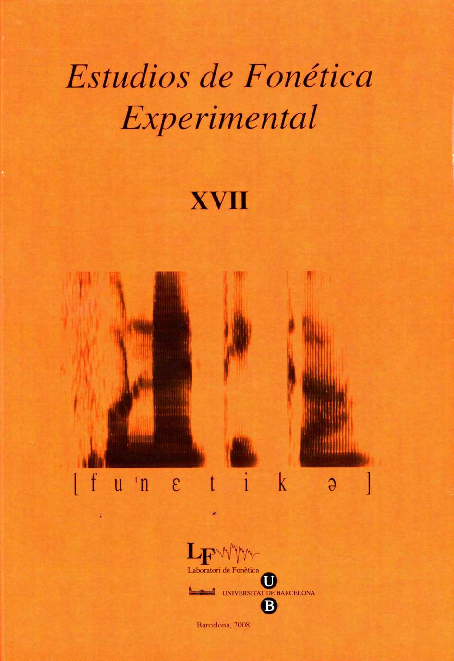La notación prosódica del español: una revisión del Sp_TOBI
Keywords:
Spanish intonation, pitch accents, bitonal and tritonal boundary tones, mid toneAbstract
The aim of this paper is to present a new proposal of prosodic transcription for Spanish intonation within the autosegmental-metrical framework, Sp_ToBI (Spa-nish ToBI). This proposal has been based on 1) traditional descriptions of Spanish intonation, 2) a revision of previous works on Sp_ToBI, and 3) a systematic analysis of the Madrid, Sevilla, and Mexico City accents. The phonological units that we propose in this version of Sp_ToBI are the following ones. The system has two monotonal pitch accents (L* and H*) and four bitonal pitch accents (L*+H, L+H*, L+>H* and H+L*). The H tones can be produced with upstep or downstep. As far as boundary tones are concerned, Spanish has three monotonal tones (L%, H%, M%), three bitonal tones (LH%, HL% y HH%) and a tritonal tone (LHL%). In line with previous studies, no phrase accents are found in Spanish intonation. This version of Sp_ToBI includes three new aspects with respect to the former model: 1) the existance of an L* pitch accent, 2) the three-way contrast of rising accents (L*+H, L+H* and L+>H*) and 3) the presence of bitonal and tritonal boundary tones.
References
BECKMAN, M. y G. AYERS (1994): Guidelines for ToBI labelling, Ms. Ohio State University. http://www.ling.ohio-state.edu/~tobi/
BECKMAN, M.; M. DÍAZ-CAMPOS; J. T. MCGORY y T. A. MORGAN (2002): «Intonation across Spanish, in the Tones and Break Indices framework», Probus, 14, pp. 9-36.
BECKMAN, M. y J. HIRSCHBERG (1994): The ToBI annotation conventions, Ms. Ohio State University.
BECKMAN, M.; J. HIRSCHBERG, J. y S. SHATTUCK-HUFNAGEL (2005): «The ori-ginal ToBI system and the Evolution of the ToBI Framework», en S. A. Jun (ed.): Prosodic Typology. The Phonology of Intonation and Phrasing, Oxford, Oxford University Press, pp. 9-54.
BUTRAGUEÑO, P. M. (2004): «Configuraciones circunflejas en la entonación del español mexicano», Revista de Filología Española, 84, pp. 347-373.
DE LA MOTA, C. (1995): La representación gramatical de la información nueva en el discurso, tesis doctoral, Universitat Autònoma de Barcelona.
ESCANDELL-VIDAL, V. (1996): «Intonation and Procedural Encoding in Interrogatives», en J. Gutiérrez-Rexach y L. Silva-Villar (eds.): Perspectives in Spanish Linguistics, Los Angeles (CA), UCLA, Department of Linguistics, pp. 35-54.
ESCANDELL-VIDAL, V. (1999): «Los enunciados interrogativos. Aspectos semánticos y pragmáticos», en I. Bosque y V. Demonte (eds.): Gramática descriptiva de la lengua española, Madrid, Real Academia Española, Espasa. Vol. 3, cap. 61, pp. 3929-3991.
FACE, T. (2001): Intonational marking of contrastive focus in Madrid Spanish, tesis doctoral, Ohio State University.
FACE, T. (2008): The Intonation of Castilian Spanish Declaratives and Absolute Interrogatives, Munich, Lincom Europa GmbH.
FACE, T. y P. PRIETO (2007): «Rising accents in Castilian Spanish: a revision of Sp-ToBI», en G. Elordieta y M. Vigário (eds.): Journal of Portuguese Linguistics (special issue on Prosody of Iberian Languages), 6.1, pp. 117-146.
FROTA, S. (2002): «Tonal association and target alignment in European Portuguese nuclear falls», en C. Gussenhoven, C. y N. Warner (eds.): Laboratory phonology VII, Berlin, Mouton de Gruyter, pp. 387-418.
HUALDE, J. I. (2003): «El modelo métrico-autosegmental», en P. Prieto (ed.): Teorías de la entonación. Barcelona, Ariel, pp. 155-184.
JUN, S. A. (2005): (ed.). Prosodic Typology. The Phonology of Intonation and Phrasing, Oxford, Oxford University Press.
LADD, D. R. (1996): Intonational Phonology, Cambridge, Cambridge Univ. Press.
MARTÍNEZ CELDRÁN, E. y A. M. FERNÁNDEZ PLANAS (2005): «Estudio metodo-lógico acerca de la obtención del corpus fijo en el proyecto AMPER», Estu-dios de Fonética Experimental, 14, pp. 29-66.
NAVARRO TOMÁS, T. (1918): Manual de pronunciación española, Madrid, CSIC, 1977 (19 edición).
NIBERT, H. J. (2000): Phonetic and phonological evidence for intermediate phra-sing in Spanish intonation, tesis doctoral, University of Illinois, Urbana-Champaign.
PIERREHUMBERT, J. (1980): The Phonetics and Phonology of English Intonation, tesis Doctoral, Massachussetts Institute of Technology.
PIERREHUMBERT, J. y M. BECKMAN (1988): Japanese Tone Structure, Cambridge, Massachussetts, MIT Press.
PRIETO, P. (2001): «L’entonació dialectal del català: el cas de les frases interrogatives absolutes», en A. Bover, M. R. Lloret y M. Vidal-Tibbits (eds.): Actes del Novè Col.loqui d’Estudis Catalans a Nord-Amèrica, Barcelona, Publicacions de l’Abadia de Montserrat, pp. 347-377.
PRIETO, P.; J. VAN SANTEN; y J. HIRSCHBERG (1995): «Tonal alignment patterns in Spanish», Journal of Phonetics, 23, pp. 429-451.
PRIETO, P.; C. SHIH y H. NIBERT (1996): «Pitch downtrend in Spanish», Journal of Phonetics, 24, pp. 445-473.
PRIETO, P. y F. TORREIRA (2007): «The segmental anchoring hypothesis revisited: Syllable structure and speech rate effects on peak timing in Spanish», Journal of Phonetics, 35, pp. 473-500.
PRIETO, P. y S. FROTA (en prep): «Boundary tones and phrase levels in Romance», Ms. Universitat Autònoma de Barcelona y Universidad de Lisboa.
QUILIS, A. (1975): «Las unidades de entonación», Revista Española de Lingüística, 5, pp. 261-279.
QUILIS, A. (1981): Fonética y acústica de la lengua española, Madrid, Gredos.
SOSA, J. M. (1999): La entonación del español, Madrid, Cátedra.
SOSA, J. M. (2003): «La notación tonal del español en el modelo Sp_ToBI», en P. Prieto (ed.): Teorías de la entonación, Barcelona, Ariel, pp. 155-184.
Downloads
Published
How to Cite
Issue
Section
License

This work is licensed under a Creative Commons Attribution-NonCommercial-NoDerivatives 4.0 International License.
All articles published online by Estudios de Fonética Experimental are licensed under Creative Commons Attribution-NonCommercial-NoDerivs 4.0 International (CC BY-NC-ND 4.0 DEED), unless otherwise noted. Estudios de Fonética Experimental is an open access journal. Estudios de Fonética Experimental is hosted by RCUB (Revistes Científiques de la Universitat de Barcelona), powered by Open Journal Systems (OJS) software. The copyright is not transferred to the journal: authors hold the copyright and publishing rights without restrictions. The author is free to use and distribute pre and post-prints versions of his/her article. However, preprint versions are regarded as a work-in-progress version used as internal communication with the authors, and we prefer to share postprint versions.




